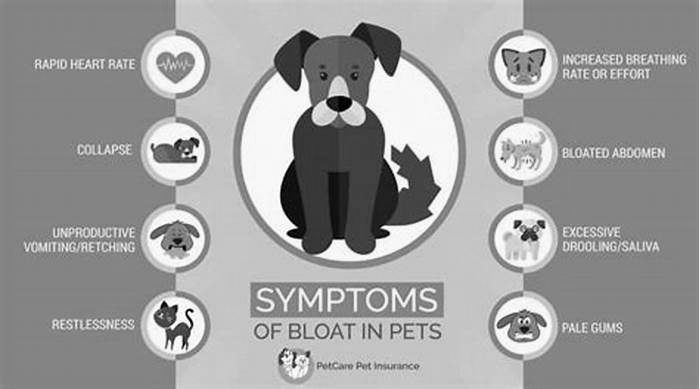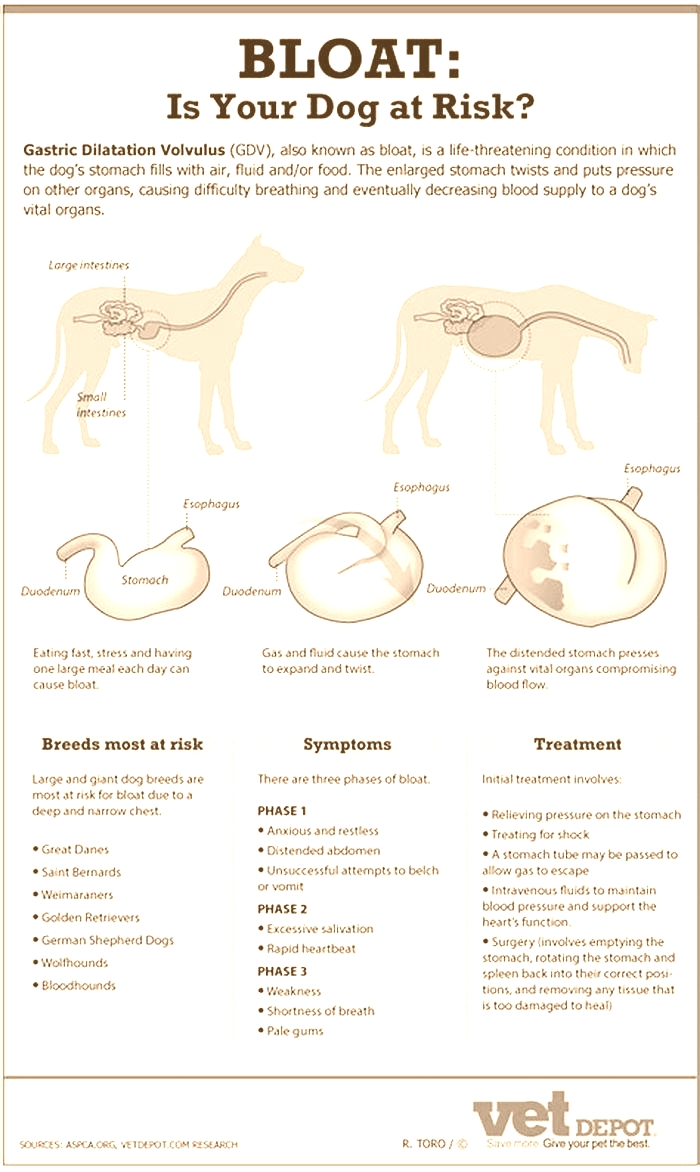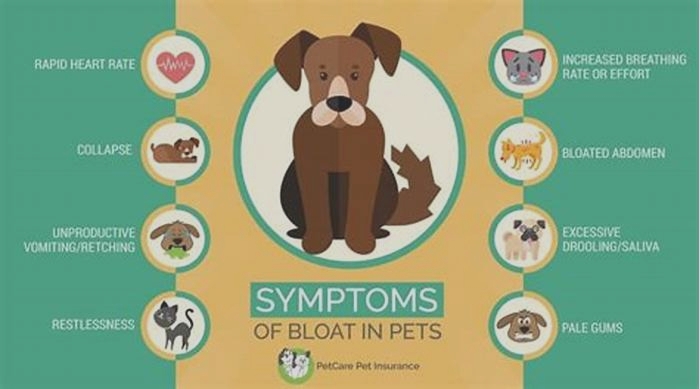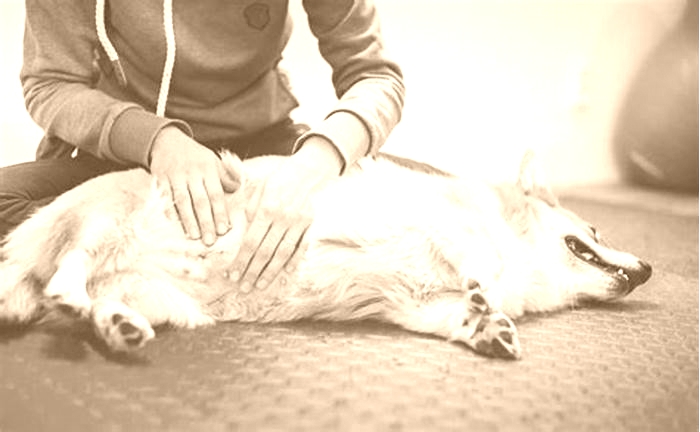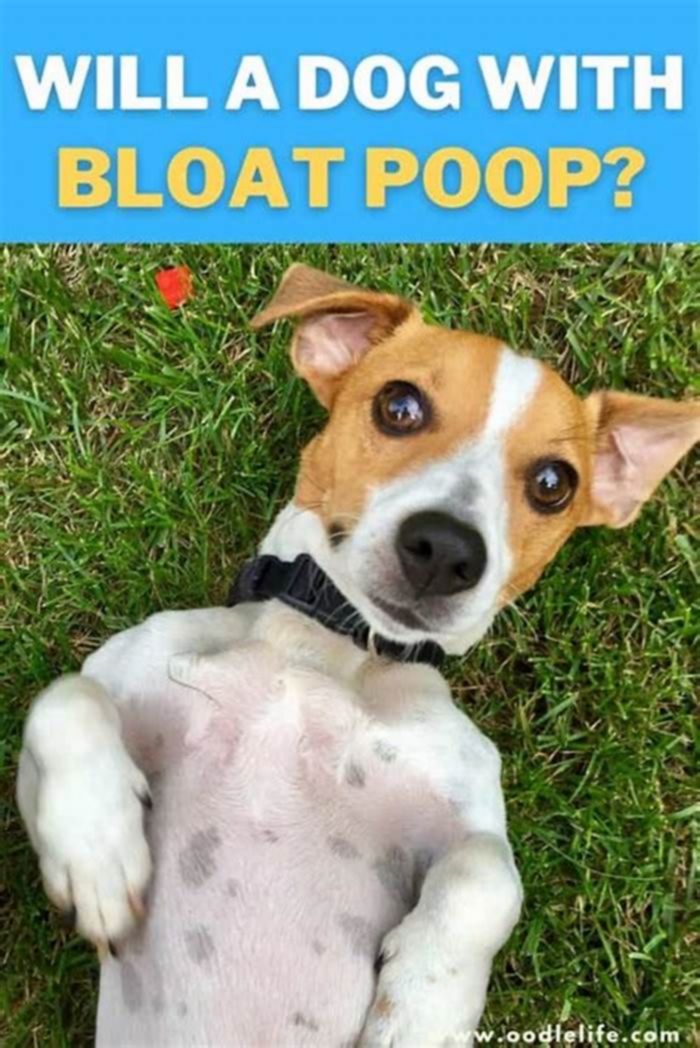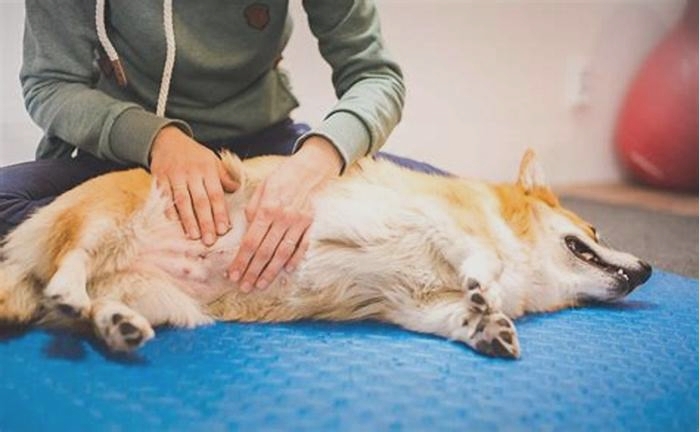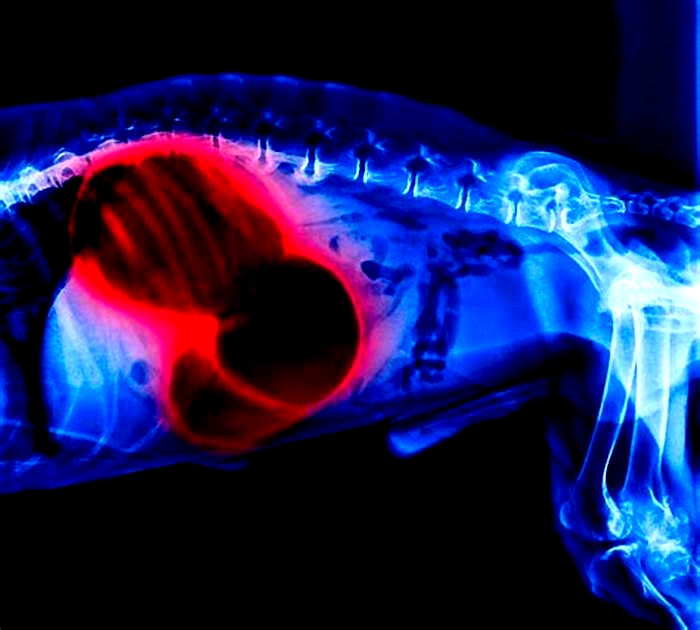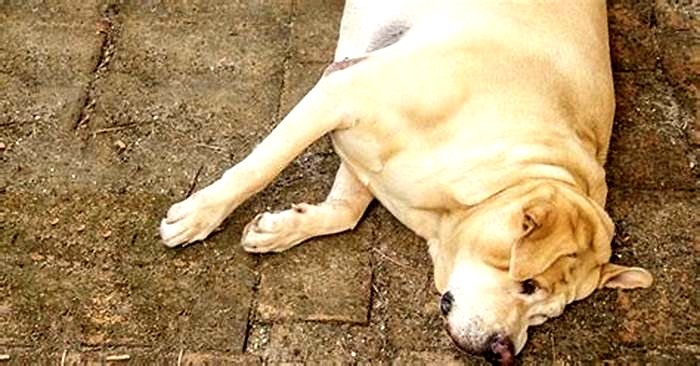How to relieve bloat in dogs
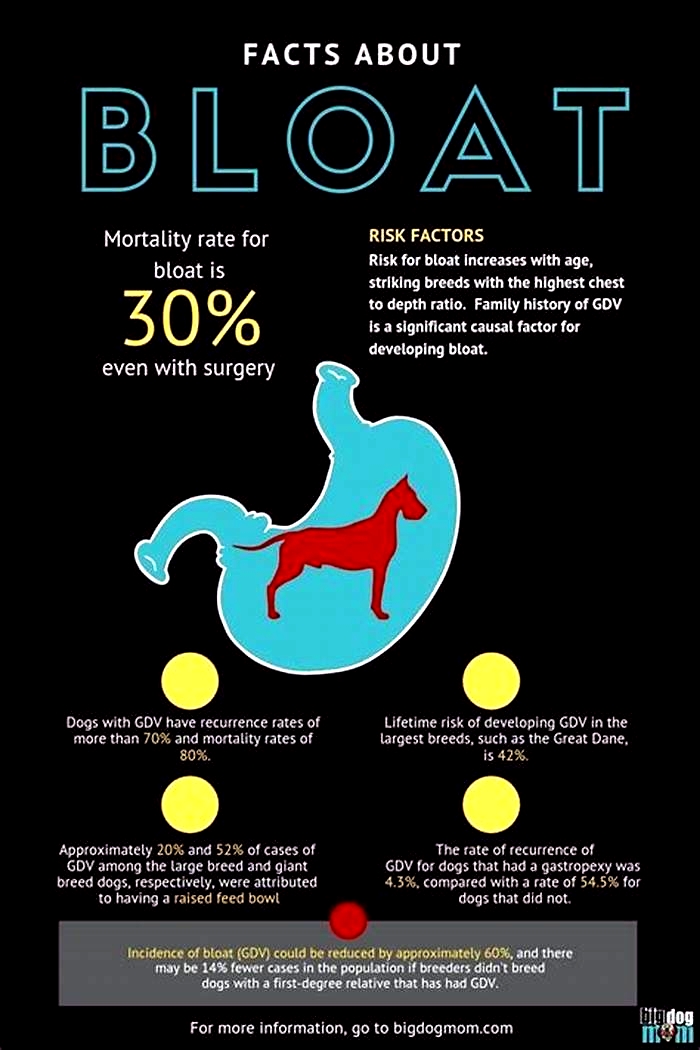
Bloat in Dogs: 7 Simple Steps That Can Save Your Dog [FAST!]
Some of the links below are affiliate links, meaning that at no additional cost to you, I will receive a commission if you click through and make a purchase. For more information, read my full affiliate disclosure here.
In its most technical terms, bloat in dogs is gastric dilatation (stomach swelling) and can include volvulus (twisting). When bloat includes volvulus it is often referred to as GDV.
I will use the terms bloat and GDV interchangeably throughout this post, however, keep in mind, they arent identical. A dog can bloat, or have an accumulation of gas, fluid, or food that causes the stomach to distend, without the volvulus or twisting of the stomach.
Commonly called bloat or gastric torsion, GDV occurs when a dogs stomach fills with gas and twists, cutting off blood and oxygen to the stomach.
As the swollen stomach pushes against surrounding organs and large blood vessels, blood flow to the heart and other organs eventually stops. Without immediate treatment, shock and a painful death occur within minutes or hours.
Bloat is the second biggest killer of dogs behind cancer.
A study published in Veterinary Surgery in 1996 estimated that 40,000 to 60,000 dogs in the United States are affected with GDV each year with a mortality rate of up to 33 percent. Beyond that study, there is a consensus in the latest research that the mortality rate for dogs with bloat, even when surgery is performed, is a shockingly high 30%.
Short on time?
Download this Quick Reference Guide for Bloat in Dogs, a beautifully designed, one-page PDF that includes the signs, symptoms, and phases of bloat and how to prevent and treat it. You will want to keep this one on your refrigerator!
Dog Breeds Prone to Bloat
Before we discuss specific bloat causes, I want to address some more defined risk factors for bloat in dogs. Breed and anatomy.
The most widely recognized and accepted risk factor is purely anatomical. You can tell a dog is going to be at higher risk for bloat just based on his or her structure.
Large, deep-chested dogs have chest cavities that are significantly longer from the spine to the sternum when compared to the width of the chest cavity viewed from the front.
Put simply, dogs that are narrow in width but who have a deep chest. You will see in a moment the list of dog breeds prone to bloat fit this very description.
This body shape may increase the risk of bloat because of a change in the relationship between the esophagus and the stomach.
In dogs with deeper abdomens, the stretching of the gastric ligaments over time may allow the stomach to descend relative to the esophagus, thus increasing the gastroesophageal angle, and this may promote bloat, says researcher, Dr. Glickman. (5)
Put another way, dogs with vertical chests are more prone to GDV because the stomach has more room to turn around and stay flipped.
In a study done at Purdue University, the Great Dane was the #1 dog at risk for bloat with over 40% of dogs affected. And based on some of the research we are going talk about in a minute, the overall lifetime risk of developing GDV in the largest dog breeds, including the Great Dane, was 42% with a case fatality rate of 30%. (2)
Following Great Danes, the two most bloat-prone dog breeds are Saint Bernard and Weimaraner. German Shepherds, Akitas, and Standard Poodles are also commonly affected.
The following is a full list of dog breeds prone to bloat:
- Great Dane
- Saint Bernard
- Weimaraner
- Doberman Pinscher
- Irish Wolfhound
- Bloodhound
- Greater Swiss Mountain Dog
- German Shepherd
- Irish Setter
- Akita
- Old English Sheepdog
- Gordon Setter
- Standard Poodle
- Boxer
- Basset Hound
Causes of Bloat in Dogs
In this section, we will address some commonly held beliefs about bloat in dogs and share which ones are backed by science and which ones arent.
Although the exact cause of GDV in dogs remains unknown, there has been a great deal of research over the last couple of years that I think you will find extremely interesting.
I am breaking this section into 6 main categories for simplicity.
- Genetics
- Age
- Raised Food Bowls or Elevated Feeders
- Water Consumption and Speed of Eating
- Type of Dog Food
- Temperament
But before we get there, I want to address how we got to where we are with respect to our understanding of what causes bloat in dogs.
Recommendations published in veterinary textbooks, magazines, and in literature promoted by dog food companies typically include the following: feed several small meals daily, avoid exercise or excessive water consumption immediately before or after eating, slow the speed of eating, moisten dry food prior to feeding and raise the level of the feed bowl to reduce air intake.
Would it surprise you to know that NONE of these recommendations have been based on sound scientific evidence, and their efficacy has never been formally evaluated?
Yep, true story.
Retrospective studies have been the primary source of information regarding risk factors for GDV. These studies have all been done on dogs who have already bloated. Hence the term retrospective.
These studies took bloat dogs and asked the question, what do all of these dogs have in common?
The problem with this type of study is that it is plagued by confounding.
This is why prospective studies are critical! These studies are done with dogs BEFORE they bloat. All factors are accounted for in a population of dogs and then tracked over a number of years.
While there is still some confounding present in prospective studies, which we will talk about, the scientific evidence supporting and disproving certain beliefs about the cause of bloat in dogs is undeniable.
Lets dive in
Genetic Cause of Bloat in Dogs
We discussed just a minute ago the impact that the dog breed and anatomical structure have on a dogs risk for bloat.
The genetic cause of bloat in dogs I am referring to is the impact of genetics WITHIN an individual breed.
In a recently completed 5-year prospective study of over 1,900 show dogs, the incidences of GDV in 7 large (50 to 99 lb) and 4 giant (> 99 lb) dog breeds were 23 and 26 cases/1,000 dog-years at risk, respectively.
The results of this study confirmed that various factors suspected to be risk factors for GDV in large breed and giant breed dogs were indeed associated with the development of the condition. This included increasing age and having a first-degree relative with a history of GDV. (2)
On the basis of the findings of the present study, the strongest recommendation to prevent GDV should be to not breed a dog that has a first-degree relative (parent, sibling, or child) that has had GDV.
Results of this study suggest that the incidence of GDV could be reduced by approximately 60%, and there may be 14% fewer cases in the population if such advice were followed. (2)
Many of you dog breeders reading this will say, But Big Dog Mom, I breed my dogs between the ages of 2 and 5, well before the age that they bloat.
This is true. You may be breeding dogs now that appear healthy but who develop GDV later in life, but you still have control over breeding siblings and children of dogs who have bloated, dont you?
Age as a Cause of Bloat in Dogs
As is the case for cancer, GDV is believed to be somehow tied to the aging process in giant-breed dogs. A similar pattern might also be observed for the large breeds in a longer study since large-breed dogs age slower than giant breeds.
I have talked about this before, in dogs, body size is inversely related to longevity.
Meaning that because the aging process is accelerated in larger dogs, diseases such as GDV will develop earlier in life in larger dogs when compared with smaller dogs. (5)
This basically means that large breed and giant breed dogs will experience their highest risk of bloat between the ages of 4 and 8, with the risk of bloat in puppies being significantly smaller.
Raised Food Bowls as a Solution for Bloat in Dogs? Not so fast
Heres where science gets really interesting!
In Non-dietary risk factors for gastric dilatation-volvulus in large- and giant-breed dogs, an article published November 15, 2000, in Volume 217, No. 10 of Journal of the American Veterinary Medical Association, more than 1,600 dogs from specific breeds were followed for a number of years. (2)
Researchers gathered information on medical history, genetic background, personality, and diet.
What researchers concluded:
Cumulative incidence of GDV during the study was 6% for large breed and giant breed dogs. Factors, they said, significantly associated with an increased risk of GDV were increasing age, having a first-degree relative with a history of GDV, having a faster speed of eating, and having a raised food bowl. (2)
avma
In fact, approximately 20% and 52% of cases of GDV among the large breed and giant breed dogs, respectively, were attributed to having a raised food bowl!
Speed of Eating and Water Intake as a Cause of Bloat in Dogs
This category is a little less cut and dry (no pun intended).
As many of the retrospective studies suggested, speed of eating was confirmed to be a risk factor for large breed dogs. However, the same was not true for giant breed dogs in the prospective studies I read.
Unfortunately, the reason for the speed of eating being a risk factor for large breed, but not giant breed dogs, was not determined in any of the research I found.
Ultimately, this suggests that we cant use a blanket recommendation to slow down the speed of eating for all dogs. Rather we need to base our recommendations to prevent GDV on the size of the dog. (5)
In addition, the prospective studies recently confirmed that there was no advantage to restricting water intake or exercise before or after eating. (2)
Here is the bottom line. Slowing a dogs speed of eating may be effective in preventing GDV in large breed dogs, but not in giant breed dogs.
If you are the owner of a large breed dog (50 100 pounds), you may consider using a slow feeder food bowllike this one.
slow feeder dog bowl
If your dog is a speed eater, you may consider adding a slow feeder to your metal dog bowl like this one from Outward Hound.
Type of Dog Food as a Cause of Bloat in Dogs
In my research, I was selfishly trying to find the proclamation that raw dog food diets are linked to a reduction in the incidence of bloat in dogs. Selfish because I am a raw feeder and I would love nothing more than to add a reduction in risk of bloat to my list of reasons why.
I was not so lucky.
What I did find was this.
Retrospective studies found that dogs fed only dry dog food or foods containing kibbles < 30 mm in diameter were at increased risk of developing GDV. Prospective studies have not confirmed dry kibble or kibble size as a cause of bloat in dogs, however.
one unexpected finding in more recent research by JAVMA:
Dry foods containing an oil or fat ingredient (e.g., sunflower oil, animal fat) among the first four ingredients were associated with a significant (P=0.01), 2.4-fold increased risk of GDV. These findings suggest that the feeding of dry dog foods that list oils or fats among the first four label ingredients predisposes a high-risk dog to GDV. (2)
javma
Temperament as a Potential Cause of Bloat in Dogs
In the 5 year AVMA study of over 1,600 dogs, temperament was measured by dog owner assessment.
What researchers found was that the Risk of GDV was increased by 257% in fearful versus non-fearful dogs. (5)
The authors postulated that physiologic differences between happy and fearful dogs might affect the function and motility of the gastrointestinal tract, especially under conditions of acute emotional stress, but they did not discuss the possibility of modifying such personality traits in dogs as part of a GDV prevention program. (5)
As someone who has dedicated considerable time into the subject of canine temperament, this finding was of particular interest to me.
My mind immediately jumps to the impact behavior-based breeding decisions might have in the overall rate of bloat or GDV in big dogs.
Signs and Symptoms of Bloat in Dogs
Facts first. There are three phases dogs go through when they bloat.
Phase I GDV:
In this phase, the stomach will start to dilate (gastric dilation) and the stomach begins to twist (gastric volvulus). A dog will present as off, anxious, pensive, restless.
Unproductive vomiting is common and only produces a white foam. The dogs abdomen may or may not be swollen during this phase.
Phase II GDV:
Due to the dilation and twisting of the stomach, the blood supply to the stomach gets cut off. The primary veins to the heart and liver are compressed and twisted. The spleen becomes engorged. Shock begins to develop. The stomach tissue during this phase is damaged.
Phase III GDV:
Due to the lack of blood flow, the spleen and stomach tissue becomes necrotic (dead). In this phase, the shock is severe and irreversible. Heart failure develops and death is imminent.
Here is a comprehensive checklist of possible bloat symptoms for your reference.
- Gagging, coughing, vomiting, or attempting to vomit. Can appear as unproductive or dry vomiting or vomiting up white foamy mucus. May occur in 5-30 minute intervals.
- Distended Abdomen with a hunched appearance
- Salivating excessively or drooling is an indication of severe pain
- Rapid, Shallow Breathing
- Pale or discolored gums
- Rapid heart rate
- Collapse
- Anxious, pacing, restless refusal to sit or lie down
- Abdominal swelling may feel tight.
- Whining
- Unproductive attempts to defecate
- Heavy panting
- Lack of normal digestive sounds
- Licking the air
- Seeks a hiding place
- Excessive drinking
I wanted to share the facts about GDV first. The bloat symptoms in dogs from a physiological point of view.
What dog owners say:
To illustrate what bloat can look like for the average big dog owner like you or me, the following are a few personal stories from members of the Big Dog Mom Community.
Kristin, a breeder of Greater Swiss Mountain Dogs for over 10 years, shared this:
In all those years, none of my dogs, or puppies I had produced, had ever bloated. Until last year when two of my own dogs bloated. The first (8 year old female) bloated. Within minutes [of loading her in the car] I heard what sounded like her trying to vomit, but this was different, it kept going on and I immediately became concerned because it was nonproductive. I pulled into my driveway within ten minutes and when I unloaded her from the car, she was so distended she looked like she did when she was about to give birth to 10 puppies! It happened that fast. I was at the vet within 10 minutes. They were able to operate and save her. She recovered well. [Then] In November, my 4 year old girl woke me up at 3 am and was obviously in distress and I could see she was quite distended. No unproductive vomiting like the other case, but clearly uncomfortable. I tried to give her some bloat buster but that did come right up, just before loading her in the car and heading to the ER. She did survive the surgery. [But 48 hours after surgery, she declind rapidly requiring another surgery.] When they got inside they found that the lining of her stomach, up to her esophagus was all necrotic. There was nothing that could be done. I asked how that could be, when she had pinked up so nicely in that initial surgery and they told me its very likely it could have been a blood clot that cut off circulation (can happen after a GDV they said). The reason she appeared to be bloating again was that she literally had NO motility at that point nothing was moving through her GI system because the stomach was pretty much dead.
Kristin
Treatment of Bloat in Dogs
The next section is NOT a recommendation to keep your dog at home if he is bloating. Quite the contrary!
If you suspect your dog is bloating, the very FIRST thing you should do is call your vet (or an emergency vet) and let them know you are on your way! Time is of the essence!
However, in this section, I want to share a few additional thoughts regarding additional tools you have in your toolbox beyond the obvious of seeking immediate veterinary care.
These are things you can do to help save your dogs life WHILE you are getting him to the veterinarian. These steps can buy you time.
Buy your dog time.
Benefits of Simethicone for Dogs
If you have never heard this word before, you arent alone. You may know it by its brand name Gas-X or Phazyme.
Remember in the beginning when I told you that bloat occurs when there is an accumulation of gas, fluid, or food that causes the stomach to distend.
While simethicone does not stop gas bubbles from forming, nor does it eliminate these bubbles, once theyve formed., it helps accelerate this process of eliminating the gas from your dogs body.
By hastening the exit of the gas, your dog will feel less bloated and more comfortable.
It accelerates the expulsion of gas by reducing the surface tension of the gas bubbles.
But because simethicone lowers the surface tension of these bubbles, they readily combine with other small bubbles. The larger bubbles that result are propelled through the intestines more rapidly, which allows them to be expelled more easily.
Simethicone works rapidly, and the results can usually be seen (well, heard, or smelled) within minutes.
Gas-X
Simethicone relieves gas and bloating in easy-to-chew tablets. This is the one I keep on hand in my bloat kit.
Phazyme
Very similar to the Gas-X and equally as good for bloat.
How Much Gas-X (Simethicone) Can I GIve my Dog?
Simethicone is very safe for dogs. It is not absorbed into the bloodstream and is usually well tolerated at unusually high doses.
Up to 8000 mg has been given to dogs without causing side effects apart from a loose stool, which is why many choose a better safe than sorry approach to this medicine and give very large amounts whenever they think their dog is bloating.
I recommend all large breed and giant breed dog owners keep simethicone on hand for an emergency home treatment for bloat. Depending on the size of your dog, you may want to give 2-4 180mg capsules or a chewable form of simethicone. Another option is a product called Bloat Buster, which is a liquid form of simethicone.
Remember, simethicone is NOT a replacement for going to the vet! This is something you can give your dog that will buy you time while en route.
What is a Bloat Kit for Dogs?
A bloat kit includes a series of products that when used in combination, can buy your dog time if he is bloating.
Lets now discuss what goes into a bloat kit and how you would use it.
If you want to see or buy a commercial bloat kit, click here. Natures Farmacy is where I bought mine and I highly recommend them.
How to make a homemade bloat kit
2. Something to keep the dogs mouth open
In the kit, I have this is a block of wood with a hole drilled through it. This can be as simple as a hard tube, like a PVC T-connector. It really doesnt matter what you use. The objective is to keep the dogs mouth open so you can insert the tube.
3. Something to keep #2 in place
You can use a strip of cloth, a roll of vet wrap, or any type of bandaging or tape that you can wrap around your dogs mouth to hold the block or tube in place.
You can use generic personal lubricant for this. Just fill a couple of small tubes or bottles with it and keep it in your kit. This is to lubricate the tube before insertion.
You can usually buy this by the foot. Get at least 4-5 feet of tubing or more depending on the size of your dog. I will show you how to measure how much tubing you will need in the Facebook Live Workshop below. You will want to measure this now and cut your tube (and melt the ends to soften the edges) so that it is ready to go in your kit should you ever need it.
And to help you with putting together your homemade bloat kit, I have compiled all of these items in a special section of my Amazon Shop here.
What to do if you suspect your dog is bloating!
Facebook Live Workshop: What is a Bloat Kit and How do you use it?
How to Prevent Bloat in Dogs
Pros and Cons of Preventive Gastropexy Surgery
One of the best ways to prevent an at-risk dog from developing a GDV is performing a prophylactic gastropexy.
This is a surgical procedure that involves surgically attaching the stomach to the body wall, thus preventing the twist or volvulus. Dogs that have a gastropexy can still bloat or have a stomach that gets large, but it cannot twist, which causes the most life-threatening problems.
If you have a bloat-prone dog but are undecided about gastropexy, the surgery may be worth considering.
Studies show dogs with GDV that dont undergo a gastropexy have recurrence rates of more than 70% and in those recurring events, mortality rates of up to 80%!
Dr. Glickman, the lead researcher at Purdue University, says they recommend prophylactic gastropexy for dogs at very high risk, such as Great Danes. Also, we do not recommend that dogs have this surgery unless they have been neutered or will be neutered at the same time.
The concern about performing a gastropexy on an unneutered dog is that it might mask expression of a disease with a genetic component in a dog that might be bred.
Additionally, the rate of recurrence of GDV for dogs that had a gastropexy was 4.3%, compared with a rate of 54.5% for dogs that did not undergo gastropexy. It seems likely, therefore, that gastropexy might be effective in preventing a first episode of GDV in genetically predisposed dogs. (2)
While there is no scientific evidence indicating that gastropexy will prevent the first occurrence of GDV, it has been shown to prevent a recurrence of GDV following an acute episode. (2)
Think of it this way, a prophylactic gastropexy is not a fix, it is just a safety net to buy you the valuable time you need to get your dog emergency veterinary care.
Because, bloat in dogs, with or without a gastropexy, is an emergency situation.
And lastly, are the logical questions of the best time to perform a gastropexy surgery and how much a gastropexy will cost.

Timing is easy. The best time to do a prophylactic gastropexy is at the time of spay or neuter.
The cost is a little more nebulous. One consideration is that emergency GDV surgery costs will be at least two-and-a-half times the cost of preventative gastropexy.
And with pet insurance, like Embrace Pet Insurance, you may be able to have all or part of the cost of gastropexy covered. I know that on the Wellness Plan for Embrace, they do cover prophylactic gastropexy. If you have different insurance, it may be worth a phone call to find out what your out-of-pocket expense would be for this type of surgery.
7 Simple Steps You Can Take Today That Can Save Your Dogs Life
- Have a bloat kit on hand and know how to use it (see the above tips and link to my Amazon Shop)
- Know your dogs family history of bloat. Consider gastropexy if your dog has a first-degree relative with a history of GDV. Add bloat to your list of questions for prospective dog breeders you interview the next time you are buying a puppy.
- Be mindful of what you are feeding While dry kibble diets are not being implicated based on current research on bloat in dogs, it seems to me dogs at the highest risk for bloat would benefit from a raw or fresh food diet. In addition, if you have a large breed dog who is a fast eater, consider investing in a slow feeder food bowl that will slow him down. Do NOT use this for a giant breed dog. Do NOT use a raised food bowl for ANY large breed or giant breed dog.
- Feed a probiotic! Probiotics not only maintain a proper gut flora, but they may also help improve the efficiency of your dogs digestive system and outcompete harmful (and potentially gas-producing) bacteria. [READ: Probiotics for Dogs: The Facts and Strains that Matter Most and The Top Dos and Donts to Protect Your Dogs Gut Health on Antibiotics]
- Have your dogs veterinarian and an emergency veterinarian pre-programmed into your phone. Time is of the essence! If you suspect your dog is bloating, you MUST act FAST. Fumbling around on Google or in your bottomless pit of a purse to find the phone number for your vet will cost you time. The time you do not have. Do this today. Do it NOW!
- Download your free Quick Reference Guide to Bloat for Dogs a comprehensive, one-page guide that includes a list of at-risk breeds, signs, symptoms, and phases of bloat, as well as how to treat and prevent bloat. This guide is a MUST-have reference for all big dog owners!
- Get Pet Health insurance. I have written extensively about the financial responsibility of large or giant breed dog ownership. This includes the cost of the dog, preventive veterinary care, food, and more emergent issues like the cost of GDV surgery. And if you are interested in gastropexy, the only pet insurance that I know of that covers the cost of this surgery is Embrace Pet Insuranceunder their Wellness Plan. Definitely check them out!
Summary
In preparation for writing this post, I reached out to the Big Dog Mom Community and did a poll. I asked big dog owners how many of them had experienced bloat or GDV in any of their dogs.
In less than 24 hours, 93 big dog owners chimed in, with nearly 30% of them having one or more experiences with bloat in their dogs. 30%!
And while that is a shockingly high percentage, I wonder what percentage of those that answered no would be prepared if they were suddenly faced with this crisis?
Would you be ready?
Make your first step in preparation, sharing this with a big dog friend.
Dog Bloat Resources and Research
- AKC Canine Health Foundation Announces New Research to Tackle Bloat in Dogs
- Non-dietary risk factors for gastric dilatation-volvulus in large- and giant-breed dogs
- A Prospective Study of Morphometric, Genetic & Dietary Risk Factors for Bloat in Dogs
- The effect of ingredients in dry dog foods on the risk of gastric dilatation-volvulus in dogs
- Incidence of and breed-related risk factors for gastric dilatation-volvulus in dogs
- Abnormalities in the Stomachs Ability to Contract Predisposes Large-Breed Dogs to Bloat
- Evaluating the Complex Genetic Basis of Bloat
- The Genetics of Bloat in German Shepherd Dogs: The Roles of Immune System Genes and the Gut Microbiome
- Terrific YouTube Video on Bloat in Dogs

